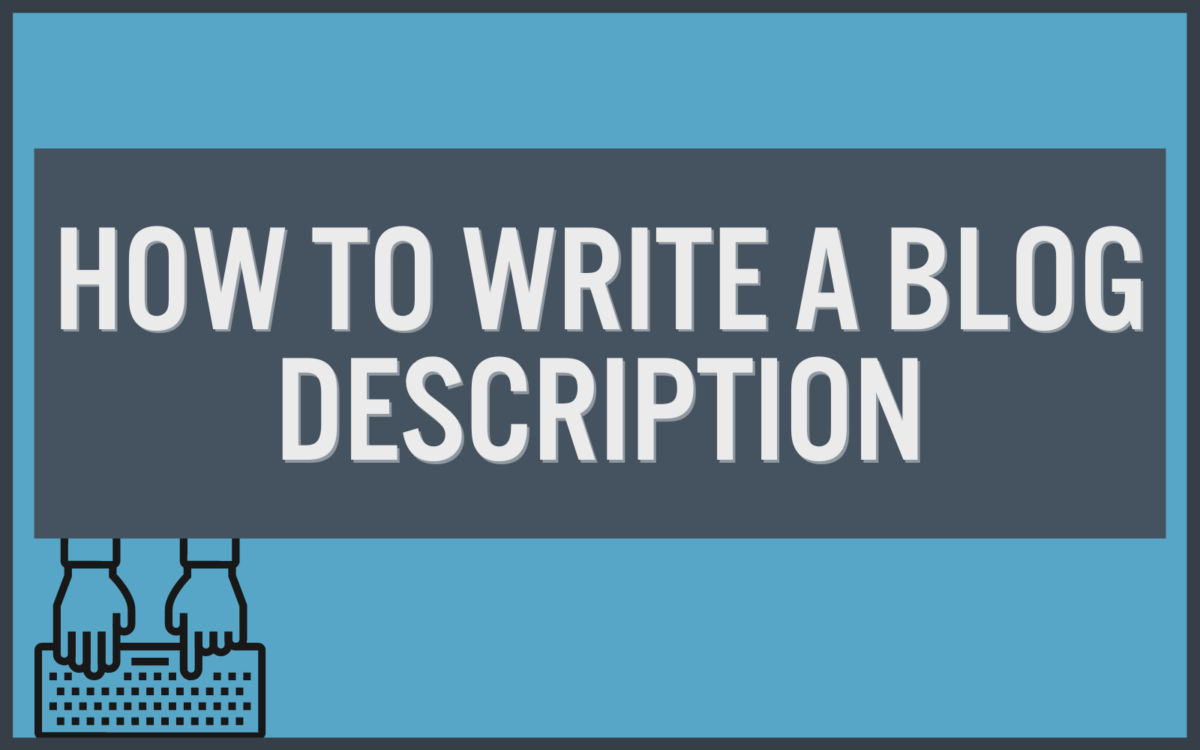How to Write a Blog Description That Boosts CTR (With Tips & Examples)

When you buy something through one of the links on our site, we may earn an affiliate commission.
There are two types of blog descriptions: the ones that make people read, and the ones that make people pass it by.
Which one is yours?
A sound digital marketing strategy for your website consists of a lot of different elements — on and off page SEO, usability, and back links, among others — but is often the little things that make all the difference.
Adding an optimized blog description to your site doesn't take very long, but it can have a huge impact on your search traffic.
Contents
What is a Blog Description?
At its most basic, a blog description is nothing more than a quick summary of what your blog is about. It tells users what to expect, reveals your personal writing style, and how the information you provide will help them with what they're looking for.
Normally, a blog description occurs as the meta description directly underneath the title in the SERPs. Since NichePursuits.com is essentially one enormous blog, the blog description appears directly underneath the title of the main page.

Like the meta description of a webpage, the blog description has to be manually entered. If not, Google will fill it in themselves with the first several lines of the page, such as this one of a local plumber.

It should be pretty obvious right away that one of these descriptions is optimized and one is not. Since this is the first thing that many people will read before actually visiting your site, it's a good idea to optimize it. Especially since 75% of the top ranking pages on Google have a meta-description.
What is a Blog Post Description?
A lot of people confuse a blog description and a blog post description. Truthfully, there's not a lot of difference between the two, with the exception of specificity.
A blog description is a description of the entire blog, regardless of individual content.
A blog post description is a description of each and every single blog post on your website.
Ironically, most people focus on writing a description of each individual blog post, and completely neglect a description of the entire blog. Each are important, but since most content marketers are optimizing for a single keyword anyway, writing a description for each one is easy to remember.
Don't forget to head to your overall blog page and write a description for it as well.

How Long Should My Blog Description Be?
Technically speaking, a blog description can be any length that you want them to be. The length of them has varied over the years, but as of 2022, the limit for meta description length is 155-160 characters.
If you decide to make your blog post longer than that, Google will insert in ellipses at the end of the description, leaving your sentence unfinished. Optimizing your blog description for that character limit ensures you have a complete thought and it doesn't appear unfinished.
What are the Benefits of Customizing a Blog Description?

Think of your blog description as a billboard for your content. As mentioned below, it should contain relevant information for your blog, but it should also make your page stand out.
A quick glance through the Google search result page will show titles and URLs that look very similar. Why? Because everyone's trying to optimize for that keyword, and they're all using the same SEO tactics to try and outdo each other.
There's nothing wrong with that, but if it all looks the same, how are you supposed to draw eyeballs to your content instead of someone else's?
The blog description is where you can allow your creativity to sell your content for you. Front-load your blog description with power words and other tidbits that will make people want to continue reading.

Additionally, using a keyword in your blog description will make that keyword appear bold, whenever people search for it. The same goes for any LSI keywords you put in your blog description as well.
If you decide not to customize your blog description, you're leaving yourself open to the mercy of Google's automated writing system.
That's never a good idea, since the last thing Google is concerned about his writing an attractive description to increase your website's click-through rate. That's your responsibility; Google doesn't care one way or the other.
Should I Use an SEO Plugin to Write a Blog Description?
If you're completely against the idea of manually writing a blog description for each one of your blog posts, then an SEO plugin may help. They still aren't ideal, as a meta description written by you will always be more relevant than one that's automatically generated.
An SEO plugin can save time, and is at least better than not writing one at all.
Below are two of the most common SEO plugins that will generate your meta description for you.
Yoast SEO Plugin
By far, one of most popular SEO plugins on the planet is used is Yoast SEO. Active on an estimated 12 million websites, Yoast automates a lot of the SEO functions for you.
But Yoast also makes it really easy to optimize your meta description. The plugin automatically creates a slot for you to insert your keyword, then gives you a green dot if your content is optimized.
Located at the bottom of the WordPress post editor, you're able to write your meta description using that keyword. Since your blog description also needs to be a certain length, it will tell you how close you are to reaching that upper limit.
Yoast is free to use, but also includes a premium plan that has several other features, including support for local search engine optimization.
Rank Math SEO Plugin
A relative newcomer to SEO plugins, Rank Math also allows you to add the meta descriptions in much the same way that Yoast does (get our full Rank Math vs Yoast breakdown).
Both of them allow you to create templates that can be copied across multiple meta descriptions, and both allow you to adjust the meta descriptions on the page itself.
The difference in price may be enough to sway someone to one side or the other. While Rank Math has a set price for all premium features, Yoast forces you to pay per upgrade.
Even though Yoast is more popular, Rank Math has an army of devoted fans who claim their sites rank better (find out more in our Rank Math Pro review).
Try Rank MathWhich one you choose is ultimately up to you, but regardless of the plugin, don't rely on its native features to do the hard work for you. Do your own keyword research and write blog descriptions that convert.
How Do I Write a Blog Description?
Writing a good blog description is the same as writing any other meta description. The major difference is that instead of writing for a single page, you have to encapsulate hundreds — and possibly thousands — of blogs into a single paragraph.
Good copywriting for a blog description isn't rocket science. With few key points to remember, you'll knock out a perfect blog description in no time.
Include Branding

As much as possible, you want to include your own branding inside the blog description. This should also be in your header and URL, but mentioning your brand inside of your description will give another touch point.
Some people will argue that your brand needs to be the very first thing said in your meta description. It's not a bad idea to do that, but including it as the first thing is best if you already have a strong brand.
Remember, people will usually only read the first several words of a description. If you believe your brand name will sell them, include it early. If not, put it near the back.
It's also important to maintain your brand voice. If your blogs are conversational, your blog description should also be conversational. If it's more of a technical website, write the description accordingly.
Use Keywords
As mentioned above, your main keyword should be included at least once inside your meta description. This is not the main keyword of an individual blog post, but what you want the entirety of your blog to represent.
For instance, you may choose to use the keyword “DIY plumbing resources” to describe your blogs (make sure to also check out our plumbing SEO guide). If that's the case, then check your domain authority and do your research to decide whether or not that word matches your audience and is within reach to rank for.
Along with your main keyword, you should also focus on a few LSI keywords that you can insert as well. Try to make these lower competition to have of a better chance to rank for them, and put them as naturally as you can into the blog description.
And please, above anything else, avoid keyword stuffing. It doesn't work, and it makes your search appearance look awful.
Answer the Question
What is the purpose of your blog to begin with? What questions are you trying to answer and what audience are you trying to serve?
This is more than just semantics; identifying and solving the need is the first step of any content marketer. It's what your blog itself is built around, so make sure that the blog description answers the most important question first.
Equally as important is showing the transformation your visitors can expect. Where are they now (i.e., what are their pain points), and how will your blog help them reach the desired end goal? Do this, and you'll find the right emotional words to drive your point home.

Create a Call To Action
No copywriting is complete without some kind of call to action (CTA). It doesn't have to be a plea for sales, but it should be an invitation to read more of your content.
Since space is at a premium, make sure that your CTA is concise. Phrases like “Want to know more?” or “Here's how” can spur the reader to action with a limited amount of real estate.
Check out our list of buying words for more information on this.
Create Curiosity or Urgency
There's never going to be a way to answer your readers' questions in 155 characters, but the main point of your blog description is to get them to keep reading. For that reason, use words that evoke curiosity or urgency.
For instance, you may make an extremely controversial point in your blog description, then invite the reader to click to learn more.
You can also claim something outrageous, such as “the world's largest library of Camaro how-to's.” Either way, you've piqued the reader's curiosity to want to engage with your content.
Learn From the Competition

When in doubt, look at the other brands in your niche to see what's working for them. Compile a list of the top blog pages and then reverse engineer them to see what's working.
(For direct examples of this, see below.)
For instance, you may see that what resonates with your audience is being direct. For others, it may be an appeal to emotion.
Still others may have found success by displaying how many readers they have.
Regardless, don't be afraid to piggyback off of other people's work to craft your own blog description.
Be Concise
155 characters is not a lot of space. It's almost exactly half the space you get in the single tweet, where long-winded commentators struggle to get the point across.
Good blog descriptions — and any meta description, for that matter — are an art. Every word needs to be scrutinized, and every sentence needs to have a purpose.
In the end, you may go through several iterations of blog descriptions before you hit the right one, so don't be afraid to do some A/B testing to find the right fit.
Examples of Great Blog Post Descriptions
As Pablo Picasso has famously said, “Good artists borrow; great artists steal.”
While you can't exactly steal someone else's description, you can mimic certain attributes of high performers. If someone has a description that really catches your eye, write it down and put it in your swipe file.
If you really want to be organized, create certain categories to elicit the types of emotion you're trying to convey. That way, you can draw on the inspiration you need a lot quicker.
Below are some good blog description examples and why they work.
Mashable

Started in 2005 by a Scottish consultant, Mashable began as a site that provided basic instructions for technology. It has since ballooned into a multi-niche blog that covers everything from entertainment to science, culture, and reviews.
Don't worry, it still handles technology too.
With so many areas to cover, you would think the blog description would be overpowering. But it's remarkably simple; just fifteen short words describe thousands of blog articles.
Mashable is an example of a big brand that relies on its reputation to sell itself. It doesn't need to tell you everything that it has on its site, because chances are, you've seen them before.
But for those who haven't, Mashable is a “global…entertainment company.” Short and sweet.
Nomadic Matt

Instead of telling you what his blogs are about, Nomadic Matt asks one simple question: “How can you travel better for less?” It's a thought that many of us wonder about on a regular basis. His blog description argues that he has the answer.
Notice that he also starts with a single word: “Welcome!” It seems cliche, but a simplistic approach is sometimes very endearing. It also makes you feel like there's a real human behind the blog, not a computer.
Sometimes the most attractive blog post description is the one that simply states a goal. Most bloggers have an objective with their blog, so why not be upfront with it?
Digital Photography School

Every brand needs a little social proof. Not only does it provide legitimacy in the eyes of your readers, but it also creates a herd mentality.
After all, if over 5 million people read Digital Photography School every month, shouldn't you?
DPS also touts the approachability of its material. You can read their resources whether you're an expert camera operator or just starting out.
It's a delicate balance to write a WordPress blog that reaches that many people consistently, but DPS nails it. It's a blog description that's worth emulating.
I Will Teach You To Be Rich

If the title of the website doesn't do it for you, the meta description tag certainly will. I Will Teach You To Be Rich is unashamedly about wealth creation and maintenance.
Not only does Ramit Sethi's blog description show where he's been featured, but he ends on the ultimate power word: “Rich.” Since that's the goal for so many, Ramit knows that ending on it will strike a chord with his readers.
But don't forget about the social proof as well. It's no small goal to be featured in The Wall Street Journal, much less ABC and CNN. If you've been featured in places like that too, put it in your search description!
The Skinny Confidential

The Skinny Confidential blog has a little bit of everything: branding, purpose, and goals.
The only thing it doesn't do right? Keeping the meta description tag under 155 characters.
This one kind of skirts the rules though, because even though there's technically an ellipsis, it ends on a complete thought. I'm not saying you can do that too, but it's not as jarring as an incomplete sentence.
Still, notice how The Skinny Confidential positions itself firmly as for “the girl who wants to be the best version of herself.” Who is that not going to relate to?
The perfect blog description shows how someone is transformed by their material. Skinny Confidential's does that in spades.
Fitbit

Anyone who's ever tried to lose weight knows how important it is to find actionable advice for success. Fitbit not only provides that in the way of tips and nutrition advice, but also success stories. They also have product announcements, motivational stories, “and more.”
In other words, a little bit of everything.
Fitbit bills itself as a “one stop shop” for all your health and exercise needs. If that's the case, why would you ever need to go anywhere else?
The Fitbit brand certainly helps draw some eyeballs, but this a great blog description example either way. It's authoritative and describes the value of coming to their site.
Backlinko

Brian Dean is known for writing detailed article after detailed article on one subject: backlinks. It's a difficult subject, but one that he knows his audience needs help with.
His goal is baked right into the first sentence of the description: how to get backlinks that “make a difference.” Getting to the top of the first page of search engines is Backlinko's reason for existence, and backlinks are how he'll take you there.
That's not to say that he only talks about backlinks. Dean covers a little of everything: on page SEO, content creation, and even email. But backlinks are his bread and butter.
Backlinko is an example of a niche within a niche. He doesn't shy away from that level of exclusivity either; instead, he bakes it right into his blog's meta description. As a result, he's at the top of most search engines for this topic.
Shout Me Loud

On the surface, it seems that Shout Me Loud goes against everything we said to actually do in this article.
They state their brand twice.
They fill their meta description with keywords like WordPress, SEO, and “make money blogging.”
They also run past the character limit of 155 words.
So what's to learn here? The reality is that there is no such thing as a perfect blog description; sometimes, you just have to break the rules.
The one thing that does sell this blog description is the claim to help you “live a dream life blogging.” It doesn't really matter what else it says, that's what people will remember.
Moz

Most digital marketers have heard of (and used) Moz.com. The reason why is stated in the blog description — they build tools that make SEO easy.
But that's not what people come to Moz for; they show up for what else the blog description says: community.
For anyone just starting out in the online space, what they crave is a group of people that are similar to them. Finding that community is really important, and Moz claims to have it.
Moreover, they claim that their brand is “built” by it. If I'm just getting going with making money online, Moz is going to be one of my first stops.
Final Words
It doesn't take much effort to optimize your blog post description, but it does take focus. Write out a good description of your blog, then try to condense it down into 155 characters.
You may never write the perfect blog description, but with any luck, you'll find your way to the top of the Google SERPs in no time.
You may also be interested in our posts on the types of blog content and the anatomy of a blog post.
Want to learn step-by-step how I built my Niche Site Empire up to a full-time income?
Yes! I Love to Learn
Learn How I Built My Niche Site Empire to a Full-time Income
- How to Pick the Right Keywords at the START, and avoid the losers
- How to Scale and Outsource 90% of the Work, Allowing Your Empire to GROW Without You
- How to Build a Site That Gets REAL TRAFFIC FROM GOOGLE (every. single. day.)
- Subscribe to the Niche Pursuits Newsletter delivered with value 3X per week
My top recommendations

















